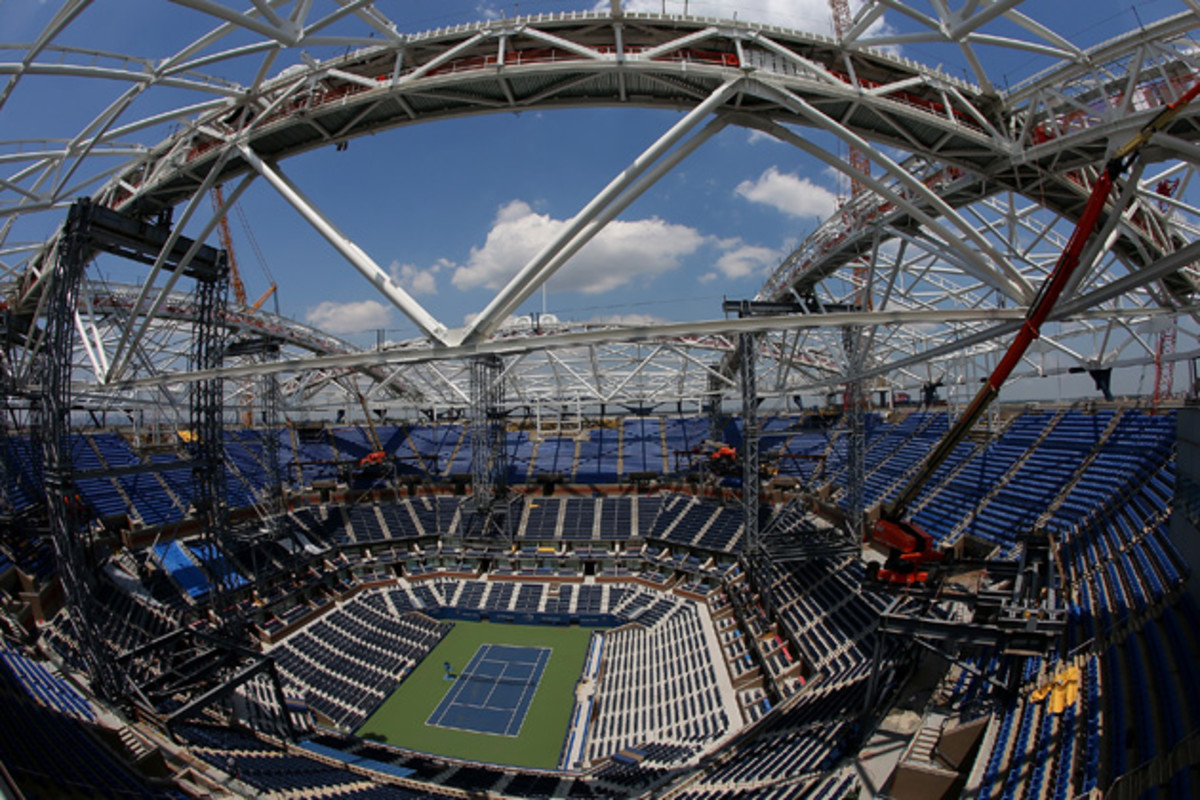New roof structure among changes at Arthur Ashe for 2015 U.S. Open

FLUSHING, N.Y. — The infamous soil at the Billie Jean King National Tennis Center made the idea of building a retractable roof over the world’s largest tennis stadium an engineering conundrum. As fans stream into the tennis center starting this week for the U.S. Open qualifying tournament, they’ll see that conundrum partially solved as the retractable roof support structure sits ready to go in gleaming white steel.
With piles driven 20 feet into the ground surrounding the 22,500-seat stadium and a steel erection in place, the new blue steel support and white steel roof structure sits poised to make a visual debut this year. The moving entrance happens in 2016.
But even without the finished $150 million project in 2015, there’s still plenty new to go along with the white steel atop Arthur Ashe Stadium.

Crews will affix all new lighting for this year to the catwalks, a new sound system and four new video screens. The new roof structure will be part of a nightly light show that will take place between the two evening matches.
“No question, this will be a different experience,” says Danny Zausner, chief operating officer of the National Tennis Center. “The steel is looking cool.”
Construction of a new roof was delayed for years over cost and engineering concerns. The entire tennis site is built on a former ash dump and adding more weight in the form of a roof to the Arthur Ashe Stadium simply wasn’t feasible.
The solution, created by Rossetti and WSP, calls for the entire roof structure—made of 5,000 tons of steel over 1,700 structural beams—to not touch the current stadium, with supports coming in the form of 24 exterior steel columns outside the stadium’s walls holding the trusses and four independent roof panels.
The top of the seating will come within 15 feet of the steel, creating a gap that allows fans to still look out toward Manhattan. To keep it climate controlled, 32 doors can close the gap when the roof shuts. But that roof will only shut for rain, not heat.
“We wanted to remain an outdoor tournament,” Zausner says.

The four major box trusses—two running in each direction—span the stadium and weigh one million pounds each at 520 feet long apiece. And they rise 200-plus feet at the height of their peak. When open, the fixed steel roof will have the tennis world’s largest stadium opening at 250 feet by 250 feet (62,500 square feet). The final piece of steel was installed above Ashe on June 10.
Zausner says the plan for all this exterior steel came after a 2009 competition to devise a solution ended up resulting in no real financially-palatable solution. WSP then took 18 months—unpaid—to craft a solution.
The final phase, which will take place after this year’s tournament, includes the two 800-ton retractable leafs of PTFE (Teflon-like) fabric that can open and close in five to seven minutes, all the mechanization for the roof and a climate control system.
But that isn’t all the work going on at the National Tennis Center in an overall $550 million renovation project. In time for 2016, crews will work to build a new Grandstand stadium, under construction now, moving it from the northeast corner to the southwest corner.
Zausner says that repositioning the court will open up the entire southern portion of the grounds, streamlining pedestrian traffic and creating a new boulevard that widens pathways from no more than 10-feet wide to 40-feet wide. Plus, additional restrooms, shade and concession amenities—think: food court!—will create an entirely new feel.
The entire center stretches an additional 30 feet to the south to make way for it all.
“It will increase capacity and make the grounds more comfortable for tens of thousands of people,” Zausner says.

Moving the Grandstand stadium—and expanding seating from 6,000 to 8,000—also allowed for some legroom elsewhere, such as new stadium seating on outer courts and the ability to accommodate a growing number of fans on nearly all the outer courts.
With Ashe and Grandstand done in 2016, expect to see a brand-new Louis Armstrong Stadium, which will expand from 10,000 to 14,000 seats, by 2018.
With two new stadiums and a newfangled retractable roof in the near future of the USTA’s BJK National Tennis Center, this year’s foreshadowing comes in the form of steel.
Tim Newcomb covers stadiums, design and gear for Sports Illustrated. Follow him on Twitter at @tdnewcomb.
